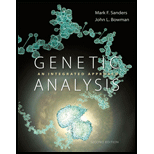
Two genes interact to produce various phenotypic ratios among
Trending nowThis is a popular solution!

Chapter 4 Solutions
Genetic Analysis: An Integrated Approach (2nd Edition)
- In sweet peas, the synthesis of purple anthocyanin pigment in the petals is controlled by two genes, B and D. What petal color would you expect in a pure breeding plant unable to catalyze the first reaction? Indicate the genotype and phenotype. 2. What petal color would you expect in a pure breeding plant unable to catalyze the second reaction? Indicate the genotype and phenotype. 3. If plants 1 and 2 are crossed, what petal color would the F1 plants have? Indicate the genotype and phenotype. 4. What ratio of purple : blue : white plants would you expect in the F2? Indicate the genotypes, phenotypes, and the F2 phenotypic ratio.arrow_forwardA homozygous strain of corn that produces yellow kernels is crossed with another homozygous strain that produces purple kernels. When the F1 are interbred, 197 of the F2 are yellow and 153 are prurple. Give the genotypes of the yellow and purple F2 and propose a genetic model that explains the inheritance of these kernel colors in corn.arrow_forwardAt the molecular level (with regard to loss-of-function alleles), explain why the ttvv homozygote has an ovate seed capsule.arrow_forward
- Familial retinoblastoma, a rare autosomal dominant defect, arose in a large family that had no prior history of the disease. Consider the following pedigree (the darkly colored symbols represent affected individuals): a. Circle the individual(s) in which the mutation most likely occurred. b. Is the person who is the source of the mutation affected by retinoblastoma? Justify your answer. c. Assuming that the mutant allele is fully penetrant, what is the chance that an affected individual will have an affected child?arrow_forwardThe gene controlling ABO blood type and the gene underlying nail-patella syndrome are said to show linkage. What does that mean in terms of their relative locations in the genome? What does it mean in terms of how the two traits are inherited with respect to each other?arrow_forwardThe following pedigree shows the pattern of inheritance of red-green color blindness in a family. Females are shown as circles and males as squares; the squares or circles of individuals affected by the trait are filled in black. What is the chance that a son of the third-generation female indicated by the arrow will be color blind if the father is not color blind? If he is color blind?arrow_forward
- Explain the following: a- No parental type is produced during gametogenesis? b- A dominant wild type produced a sign spot in Drosophila? c- 9:7 phenotypic ratio is produced in dihybrid cross? d- 50% parental type gametes were produced during gametogenesis? e- All recombinant gametes were produced during gametogenesis?arrow_forwardThe following is a linkage map of chromosome 5 for three genes in tomato: (see image) The cross between the triple heterozygote (Lf J W/ lf j w) and a triple homozygous recessive produced 500 progeny. Assume that there is no interference in the Lf-W region. Give the expected number of individuals for each of the following progeny types and show complete solutions.a. with crossover in the Lf-J and J-W regionsb. with crossover in the Lf-J regionc. with crossover in the J-W regiond. without crossover in the Lf-W regionarrow_forwardThree enzymes are part of a sequential pathway that produces a pigment that makes flowers red. Each enzyme is the gene product of a different locus. If a trihybrid, heterozygous (+/-) for each of the three loci, is selfed, what fraction of the offspring will not be able to produce the red pigment (and will thus have white flowers)? Express your answer as a number between 0 and 1, rounding to 2 decimal places. For example, if you think 1/4 of the offspring will have white flowers, then answer 0.25arrow_forward
- Two plants with white flowers, each from true-breeding strains, were crossed. All the F1 plants had red flowers. When these F1 plants were intercrossed, they produced an F2 consisting of 177 plants with red flowers and 142 with white flowers. (a) Propose an explanation for the inheritance of flower color in this plant species. (b) Propose a biochemical pathway for flower pigmentation and indicate which genes control which steps in this pathway.arrow_forwardOne particularly useful feature of the Hardy-Weinberg equation is that it allows us to estimate the frequency of heterozygotes for recessive genetic diseases, assuming that Hardy-Weinberg equilibrium exists. As an example, let’s consider cystic fibrosis, which is a human genetic disease involving a gene that encodes a chloride transporter. Persons with this disorder have an irregularity in salt and water balance. One of the symptoms is thick mucus in the lungs that can contribute to repeated lung infections. In populations of Northern European descent, the frequency of affected individuals is approximately 1 in 2500. Because this is a recessive disorder, affected individuals are homozygotes. Assuming that the population is in Hardy-Weinberg equilibrium, what is the frequency of individuals who are heterozygous carriers?arrow_forwardMultiple crosses were made between true-breeding lines of black and yellow Labrador retrievers. All the F1 progeny were yellow. When these progeny were intercrossed, they produced an F2 consisting of 121 yellow, 9 black and 30 chocolate. What epistatic ratio and what kind of epistasis is approximated in the F2? Propose a biochemical pathway for coat color in Labrador retrievers based on the type of epistasis. Correlate each genotype with the phenotype that would occur in your pathway. Also show the frequency of each genotype. A-B- A-bb aaB- aabbarrow_forward
 Human Biology (MindTap Course List)BiologyISBN:9781305112100Author:Cecie Starr, Beverly McMillanPublisher:Cengage Learning
Human Biology (MindTap Course List)BiologyISBN:9781305112100Author:Cecie Starr, Beverly McMillanPublisher:Cengage Learning Human Heredity: Principles and Issues (MindTap Co...BiologyISBN:9781305251052Author:Michael CummingsPublisher:Cengage Learning
Human Heredity: Principles and Issues (MindTap Co...BiologyISBN:9781305251052Author:Michael CummingsPublisher:Cengage Learning

